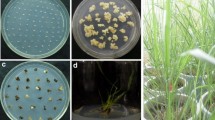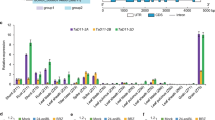Abstract
The number of viable shoots influences the overall architecture and productivity of wheat (Triticum aestivum L.). The development of lateral branches, or tillers, largely determines the resultant canopy. Tillers develop from the outgrowth of axillary buds, which form in leaf axils at the crown of the plant. Tiller number can be reduced if axillary buds are not formed or if the outgrowth of these buds is restricted. The teosinte branched1 (tb1) gene in maize, and homologs in rice and Arabidopsis, genetically regulate vegetative branching. In maize, increased expression of the tb1 gene restricts the outgrowth of axillary buds into lateral branches. In this study, the maize tb1 gene was introduced through transformation into the wheat cultivar “Bobwhite” to determine the effect of tb1 overexpression on wheat shoot architecture. Examination of multiple generations of plants reveals that tb1 overexpression in wheat results in reduced tiller and spike number. In addition, the number of spikelets on the spike and leaf number were significantly greater in tb1-expressing plants, and the height of these plants was also reduced. These data reveal that the function of the tb1 gene and genetic regulation of lateral branching via the tb1 mode of action is conserved between wheat, rice, maize and Arabidopsis. Thus, the tb1 gene can be used to alter plant architecture in agriculturally important crops like wheat.



Similar content being viewed by others
References
Aguilar-Martinez JA, Poza-Carrion C, Cubas P (2007) Arabidopsis BRANCHED1 acts as an integrator of branching signals within axillary buds. Plant Cell 19:458–472
Arite T, Iwata H, Ohshima K, Maekawa M, Nakajima M, Kojima M, Sakakibara H, Kyozuka J (2007) DWARF10, an RMS1/MAX4/DAD1 ortholog, controls lateral bud outgrowth in rice. Plant J 51:1019–1029
Austin RB, Jones HG (1975) The physiology of wheat. In: Plant Breeding Institute, Annual Report 1974, Cambridge, pp 20–73
Babb S, Muehlbauer GJ (2003) Genetic and morphological characterization of the barley uniculm2 (cul2) mutant. Theor Appl Genet 106:846–857
Bennett T, Leyser O (2006) Something on the side: axillary meristems and plant development. Plant Mol Biol 60:843–854
Campbell BT, Baenziger PS, Sato AMS, Clemente T (2000) Inheritance of multiple transgenes in wheat. Crop Sci 40:1133–1141
Christensen AH, Sharrock RA, Quail PH (1992) Maize polyubiquitin genes: structure, thermal perturbation of expression and transcript splicing, and promoter activity following transfer to protoplasts by electroporation. Plant Mol Biol 18:675–689
Cubas P, Lauter N, Doebley J, Coen E (1999) The TCP domain: a motif found in proteins regulating plant growth and development. Plant J 18:215–222
Damerval C, Le Guilloux M, Jager M, Charon C (2007) Diversity and evolution of CYCLOIDEA-like TCP genes in relation to flower development in Papaveraceae. Plant Physiol 143:759–772
de la Peña RC, Murray TD, Jones SS (1996) Linkage relations among eyespot resistance gene Pch2, endopeptidase Ep-A1b, and RFLP marker Xpsr121 on chromosome 7A of wheat. Plant Breed 115:273–275
Doebley J, Stec A, Gustus C (1995) teosinte branched1 and the origin of maize: evidence for epistasis and the evolution of dominance. Genetics 141:333–346
Doebley J, Stec A, Hubbard L (1997) The evolution of apical dominance in maize. Nature 386:485–488
Grbic V, Bleecker AB (2000) Axillary meristem development in Arabidopsis thaliana. Plant J 21:215–223
Hubbard L, McSteen P, Doebley J, Hake S (2002) Expression patterns and mutant phenotype of teosinte branched1 correlate with growth suppression in maize and teosinte. Genetics 162:1927–1935
Ishikawa S, Maekawa M, Arite T, Onishi K, Takamure I, Kyozuka J (2005) Suppression of tiller bud activity in tillering dwarf mutants of rice. Plant Cell Physiol 46:79–86
Jefferson RA, Kavanagh TA, Bevan MW (1987) Gus fusions: beta-glucuronidase as a sensitive and versatile gene fusion marker in higher-plants. EMBO J 6:3901–3907
Kuraparthy V, Sood S, Dhaliwal HS, Chhuneja P, Gill BS (2007) Identification and mapping of a tiller inhibition gene (tin3) in wheat. Theor Appl Genet 114:285–294
Li CX, Potuschak T, Colon-Carmona A, Gutierrez RA, Doerner P (2005) Arabidopsis TCP20 links regulation of growth and cell division control pathways. Proc Natl Acad Sci USA 102:12978–12983
Long J, Barton MK (2000) Initiation of axillary and floral meristems in Arabidopsis. Dev Biol 218:341–353
Luo D, Carpenter R, Vincent C, Copsey L, Coen E (1996) Origin of floral asymmetry in Antirrhinum. Nature 383:794–799
Mackintosh CA, Garvin DF, Radmer LE, Heinen SJ, Muehlbauer GJ (2006) A model wheat cultivar for transformation to improve resistance to Fusarium head blight. Plant Cell Rep 25:313–319
McSteen P, Leyser O (2005) Shoot branching. Annu Rev Plant Biol 56:353–374
Muller D, Schmitz G, Theres K (2006) Blind homologous R2R3 Myb genes control the pattern of lateral meristem initiation in Arabidopsis. Plant Cell 18:586–597
Nath U, Crawford BCW, Carpenter R, Coen E (2003) Genetic control of surface curvature. Science 299:1404–1407
Peterson CM, Klepper B, Rickman RW (1982) Tiller development at the coleoptilar node in winter wheat. Agron J 74:781–784
Rawson HM, Evans LT (1971) The contribution of stem reserves to grain development in a range of wheat cultivars of different height. Aust J Agric Res 22:851–863
Rickman RW, Klepper BL, Peterson CM (1983) Time distributions for describing appearance of specific culms of winter wheat. Agron J 75:551–556
Takeda T, Suwa Y, Suzuki M, Kitano H, Ueguchi-Tanaka M, Ashikari M, Matsuoka M, Ueguchi C (2003) The OsTB1 gene negatively regulates lateral branching in rice. Plant J 33:513–520
Takeda T, Amano K, Ohto MA, Nakamura K, Sato S, Kato T, Tabata S, Ueguchi C (2006) RNA interference of the Arabidopsis putative transcription factor TCP16 gene results in abortion of early pollen development. Plant Mol Biol 61:165–177
Wang RL, Stec A, Hey J, Lukens L, Doebley J (1999) The limits of selection during maize domestication. Nature 398:236–239
Ward SP, Leyser O (2004) Shoot branching. Curr Opin Plant Biol 7:73–78
Weeks JT, Anderson OD, Blechl AE (1993) Rapid production of multiple independent lines of fertile transgenic wheat (Triticum aestivum). Plant Physiol 102:1077–1084
Zou JH, Zhang SY, Zhang WP, Li G, Chen ZX, Zhai WX, Zhao XF, Pan XB, Xie Q, Zhu LH (2006) The rice HIGH-TILLERING DWARF1 encoding an ortholog of Arabidopsis MAX3 is required for negative regulation of the outgrowth of axillary buds. Plant J 48:687–696
Acknowledgments
We thank the Minnesota Agricultural Experiment Station for partial funding. We thank John Doebley (University of Wisconsin) for the maize tb1 gene and Peter Quail (USDA-ARS, Albany, CA) for the pAHC17 and pAHC25 plasmids.
Author information
Authors and Affiliations
Corresponding author
Additional information
Communicated by R. Rose.
Rights and permissions
About this article
Cite this article
Lewis, J.M., Mackintosh, C.A., Shin, S. et al. Overexpression of the maize Teosinte Branched1 gene in wheat suppresses tiller development. Plant Cell Rep 27, 1217–1225 (2008). https://doi.org/10.1007/s00299-008-0543-8
Received:
Revised:
Accepted:
Published:
Issue Date:
DOI: https://doi.org/10.1007/s00299-008-0543-8




